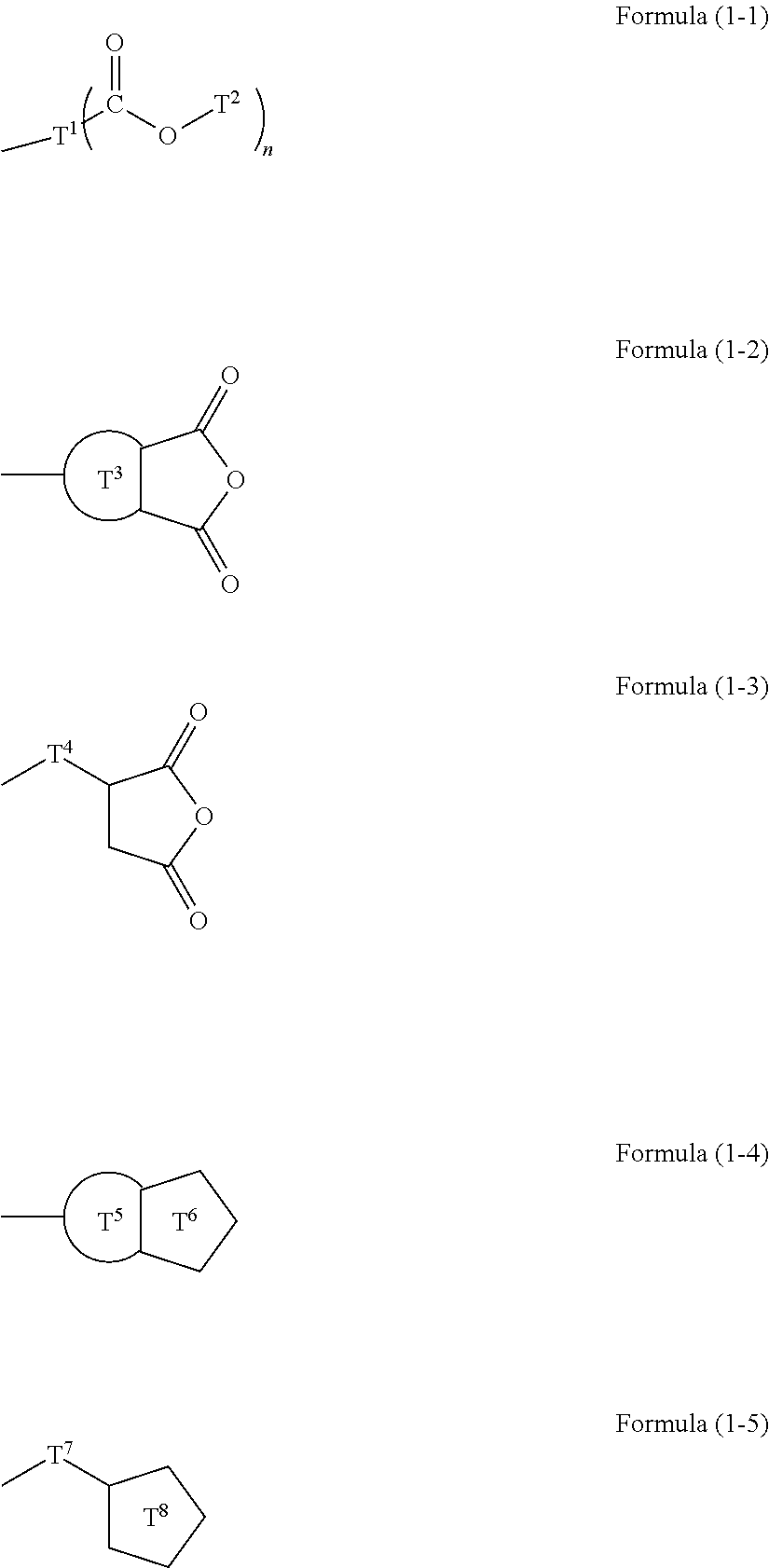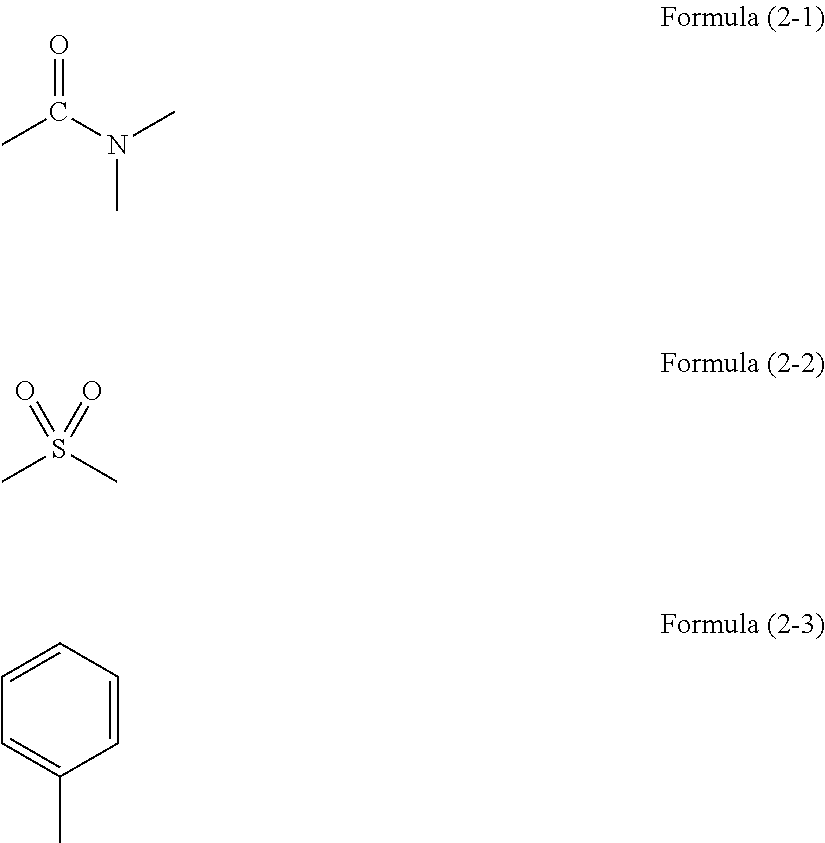Resist underlayer film forming composition containing silicon having ester group
- Summary
- Abstract
- Description
- Claims
- Application Information
AI Technical Summary
Benefits of technology
Problems solved by technology
Method used
Image
Examples
synthesis example 1
[0190]15.40 g (75 mol % in all silanes) of tetraethoxysilane, 1.23 g (7 mol % in all silanes) of methyltriethoxysilane, 1.37 g (7 mol % in all silanes) of phenyltrimethoxysilane, 1.72 g (6 mol % in all silanes) of methylsulfonyl methylphenyl trimethoxysilane, 1.62 g (5 mol % in all silanes) of (5-(triethoxysilyl)norbornene-2,3-dicarboxylic anhydride, and 32.00 g of acetone were charged into a 100 mL flask. While the resultant mixture solution was stirred with a magnetic stirrer, 6.66 g of a 0.01 mol / L hydrochloric acid was added dropwise into the mixture solution. After the completion of the addition, the flask was transferred into an oil bath adjusted to 85° C., and under warming-reflux, the reaction was effected for 240 minutes. Then, the reaction solution was cooled down to room temperature and to the reaction solution, 21 g of propylene glycol monomethyl ether acetate was added. From the resultant reaction solution, ethanol as a reaction by-product, water, and hydrochloric acid ...
synthesis example 2
[0191]15.48 g (75 mol % in all silanes) of tetraethoxysilane, 1.24 g (7 mol % in all silanes) of methyltriethoxysilane, 1.37 g (7 mol % in all silanes) of phenyltrimethoxysilane, 1.73 g (6 mol % in all silanes) of methylsulfonyl methylphenyl trimethoxysilane, 1.51 g (5 mol % in all silanes) of 3-(triethoxysilyl)propylsuccinic anhydride, and 31.98 g of acetone were charged into a 100 mL flask. While the resultant mixture solution was stirred with a magnetic stirrer, 6.69 g of a 0.01 mol / L hydrochloric acid was added dropwise into the mixture solution. After the completion of the addition, the flask was transferred into an oil bath adjusted to 85° C., and under warming-reflux, the reaction was effected for 240 minutes. Then, the reaction solution was cooled down to room temperature and to the reaction solution, 21 g of propylene glycol monomethyl ether acetate was added. From the resultant reaction solution, ethanol as a reaction by-product, water, and hydrochloric acid were distilled...
synthesis example 3
[0192]15.44 g (75 mol % in all silanes) of tetraethoxysilane, 1.23 g (7 mol % in all silanes) of methyltriethoxysilane, 1.37 g (7 mol % in all silanes) of phenyltrimethoxysilane, 1.72 g (6 mol % in all silanes) of methylsulfonyl methylphenyl trimethoxysilane, 1.56 g (5 mol % in all silanes) of the compound 1, and 31.99 g of acetone were charged into a 100 mL flask. While the resultant mixture solution was stirred with a magnetic stirrer, 6.68 g of a 0.01 mol / L hydrochloric acid was added dropwise into the mixture solution. After the completion of the addition, the flask was transferred into an oil bath adjusted to 85° C., and under warming-reflux, the reaction was effected for 240 minutes.
Then, the reaction solution was cooled down to room temperature and to the reaction solution, 21 g of propylene glycol monomethyl ether acetate was added. From the resultant reaction solution, ethanol as a reaction by-product, water, and hydrochloric acid were distilled off under reduced pressure a...
PUM
| Property | Measurement | Unit |
|---|---|---|
| Percent by mole | aaaaa | aaaaa |
| Percent by mole | aaaaa | aaaaa |
Abstract
Description
Claims
Application Information
 Login to View More
Login to View More - R&D
- Intellectual Property
- Life Sciences
- Materials
- Tech Scout
- Unparalleled Data Quality
- Higher Quality Content
- 60% Fewer Hallucinations
Browse by: Latest US Patents, China's latest patents, Technical Efficacy Thesaurus, Application Domain, Technology Topic, Popular Technical Reports.
© 2025 PatSnap. All rights reserved.Legal|Privacy policy|Modern Slavery Act Transparency Statement|Sitemap|About US| Contact US: help@patsnap.com



